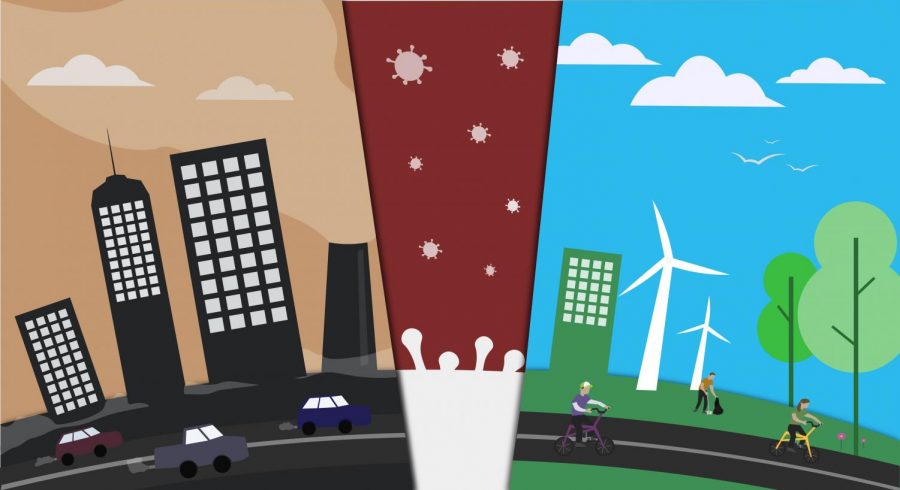Recovery from COVID-19 must prioritize climate action
Crisis gives the United States a chance to reverse its disgraceful environmental record through Green New Deal
Art by Sophie Livingston. As the world recovers from the COVID-19 pandemic, we must prioritize climate action. Many have proposed policies such as the Green New Deal to address both economic and environmental issues.
May 24, 2020
Throughout the COVID-19 pandemic, declining greenhouse gas emissions and the return of wildlife to quarantined cities have offered the United States a sliver of hope. Once the crisis is resolved and America is left to jumpstart its ailing economy, we must center environmental reform in any stimulus package.
According to the Washington Post, worldwide emissions have dropped a whopping 17% over the last few months — a decline of nearly 1 billion tons of carbon dioxide emitted into the atmosphere. Come New Years, it is estimated annual greenhouse gas emissions will decline by 4% to 7% compared to 2019. While this is clearly beneficial in the fight against climate change, quarantine-induced drops in emissions will not impact long term trends and we cannot lose sight of the fight for climate action as we reopen the country.
It seems likely that the United States has entered into a recession, requiring action and economic stimulus across all levels of government. In addition to addressing climate change, our policy must take on inequality which is likely to be exacerbated as the downturn throws millions more into poverty while the rich rake in obscenely large amounts of money. By passing a Green New Deal — a basket of policies meant to greatly expand the nation’s safety net and equitably address climate change — we can kill two birds with one stone: mass inequality and environmental destruction.
To restart the economy and prevent a modern Great Depression, we must create millions of jobs and pour billions back into the economy. The Green New Deal would do both. According to Scientific American, the basket of policies would create roughly 1.5 million jobs annually for the next decade and roughly 3.5 million jobs annually for the subsequent decade. Why would we need so many workers? Well, to speed up the transition to renewable energy on the electric grid, build green infrastructure, broaden public transportation and more — effectively combating climate change.
The Green New Deal would also address rising social and economic inequality that has effectively killed the American dream. Most Green New Deal proposals incorporate policies like universal healthcare and greater accessibility to higher education which would help the poorest Americans survive the current crisis, and once again create the social mobility our nation lost decades ago.
So, through the Green New Deal, America could not only address inequality and the coronavirus recession, but also fight climate change which promises to devastate our nation over the decades to come.
Policies like this can be implemented at the state level as well. Last year, I worked with state representative Frank Hornstein to draft the Minnesota Green New Deal. If passed, this legislation would direct the state agencies to investigate how to decarbonize their various fields while bringing education to the underprivileged and creating tens of thousands of jobs across the state.
Some argue these policies would kill jobs in carbon-intensive industries. Although to a certain extent that may be true — if we phase out coal, we will not need coal miners — the Green New Deal itself addresses that. In the Minnesota Green New Deal, for example, the state would support any displaced workers in finding the education and the jobs they need to restart their lives.
Other critics claim the Green New Deal is too costly or unnecessary. Although the program is expensive, any new stimulus package meant to save the economy would cost just as much. The Green New Deal is the best option as it will have the added benefit of supporting the environment and mitigating the impacts of climate change on frontline communities. And for those who question the importance of addressing climate change at this scale, it is already clear that individual action is not enough to combat rising emissions — the majority of climate scientists support large-scale, societal change. We need systematic reform, and the Green New Deal delivers.
Besides legislative action like the Green New Deal, smaller communities can also take action as we reopen. Cities like Minneapolis and St. Louis Park can make temporary bike and pedestrian paths established for use during quarantine permanent and can continue to expand access to public transport.
Community leaders can also continue to educate the public on climate change and environmental justice. Local officials must prioritize climate action in city government, just as newly-elected St. Louis Park City Councilor Larry Kraft — who ran on a platform of climate action — is already doing.
The time to act is now. To save our jobs and to save our planet, we need a Green New Deal.




